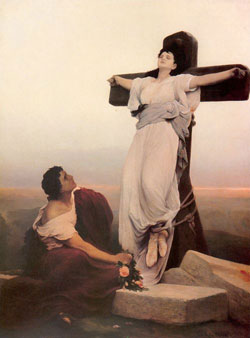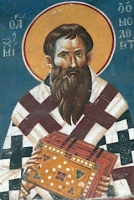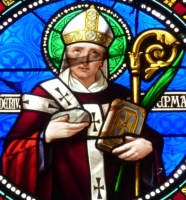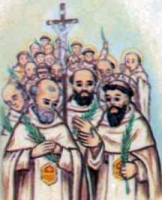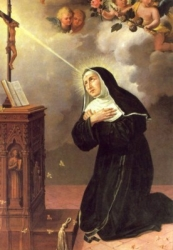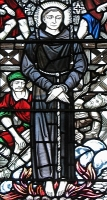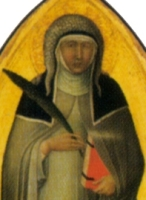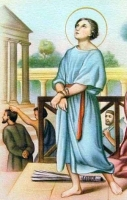St. Julia
கோர்ஸிகாவின் புனிதர் ஜூலியா
கன்னியர்/ மறைசாட்சி:
பிறப்பு: ஜூலை 25
கர்தாஜ், மேற்கத்திய ரோமப் பேரரசு
இறப்பு: கி.பி. 5ம் நூற்றாண்டு (439)
கோர்ஸிகா, மேற்கத்திய ரோமப் பேரரசு
ஏற்கும் சமயம்:
ரோமன் கத்தோலிக்க திருச்சபை
கிழக்கு மரபுவழி திருச்சபை
புனிதர் பட்டம்: ஃபெப்ரவரி 14
நினைவுத் திருவிழா: மே 23
பாதுகாவல்:
கோர்ஸிகா (Corsica), லிவோர்னோ (Livorno),
சித்திரவதையால் பாதிக்கப்பட்டவர்கள் (Torture victims)
கைகள் மற்றும் கால்களின் நோய்க்குறிகள் (Pathologies of the hands and the feet)
புனிதர் “கோர்சிகாவின் ஜூலியா” (Saint Julia of Corsica) என்றும், புனிதர் “கார்தாஜ்’ன் ஜூலியா” (Saint Julia of Carthage) என்றும், புனிதர் நோன்ஸா’வின் ஜூலியா (Saint Julia of Nonza) என்றும் அறியப்படும் புனிதர் ஜூலியா, கன்னியரும், மறைசாட்சியும் ஆவார். இவரும் புனிதர் “டெவோட்டா’வும் (Saint Devota) கோர்ஸிகா’வின் (Corsica) பாதுகாவலர்களாக திருச்சபையினால் அறிவிக்கப்பட்டுள்ளனர்.
ரோமானிய ஆட்சியின் கீழே “கோர்சிகா” கிறிஸ்தவ மறையை தழுவியதன் முன்னர் (Pre-Christian Corsica under Roman rule) நடந்த கிறிஸ்தவர்களின் துன்புருத்தல்களின்போது இவர்கள் மறைசாட்சிகளாக கொல்லப்பட்டதாக சரித்திரம் இயம்புகின்றது.
“விக்டர் விட்டேன்சிஸ்” (Victor Vitensis) எனும் ஒரு ஆபிரிக்க ஆயர் (Bishop of Africa), ரோம சாம்ராஜ்ஜியத்தின் ஆபிரிக்க பிராந்திய நாடான “வண்டல்ஸ்” (Vandals) நாட்டின் அரசர்கள் “ஜீஸெரிக்” (Geiserici) மற்றும் “ஹனுரிக்” (Hunirici) ஆகியோரின் காலத்தில் நடைபெற்ற கிறிஸ்தவ துன்புறுத்தல்கள் பற்றிய சரித்திர பதிவுகளை எழுதினார்.
கி,பி, 429ம் ஆண்டு, அரசன் “ஜீஸெரிக்” (Geiseric) சுமார் 80,000 பழங்குடியினருடன் ஸ்பெயின் நாட்டிலிருந்து ஆபிரிக்கா நோக்கி படையெடுத்தான். கி.பி. சுமார் 439ம் ஆண்டு, “கார்தாஜ்” (Carthage) நாட்டை கைப்பற்றினான். அதன் பின்னர் அவன் அங்குள்ள கிறிஸ்தவ மக்களை “ஆரியனிஸ” (Arianism) மதத்திற்கு மாற்ற எடுத்துக்கொண்ட கொடுங்கோல் துன்புறுத்தல் நடவடிக்கைகள் அப்போதிருந்த கிறிஸ்தவ ஆயர்கள் எவராலும் மறக்கவோ, பொறுத்துக்கொள்ளவோ இயலாததாகும்.
ஜூலியா, ஒரு “கார்தாஜ்” (Carthaginian girl) பெண்ணாவார். அவர் “யூசேபியஸ்” (Eusebius) என்பவனால் அவரது நகரிலிருந்து பிடித்து கொண்டுவரப்பட்டார். பின்னர் அவரை அடிமையாக விற்றான். இதுபோலவே கீழ்படியாத கிறிஸ்தவர்கள் பலரை அவர்கள் அகற்றினார்கள். “யூசேபியஸ்” (Eusebius) ஒரு பாலஸ்தீனிய நாட்டின் சிரிய (Citizen of Syria in Palestine) பிரஜை ஆவான். “கேப் கோர்ஸ்” (Cap Corse) துறைமுகத்தில் நங்கூரமிட்டிருந்த சரக்குக் கப்பலில் போதையின் கொண்டாட்டத்தின் உச்சத்தில் இருந்தனர். அவர்களின் பாவச் செயல்களுக்காக ஜூலியா மிகவும் மன வருத்தத்தில் இருந்தார். கப்பலிலுள்ள ஒரு பெண், பாகனிய கடவுளர்களை பூஜிக்க மறுப்பதாகவும், ஏளனம் செய்வதாகவும் “ஃபெலிக்ஸ் சாக்சோ” (Felix Saxo) என்பவனிடம் கூறினர். ஃபெலிக்ஸ், அப்பெண்ணை நமது வழிக்கு கொண்டுவாருங்கள்; அல்லது அவளை என்னிடம் கொண்டுவாருங்கள் என்று யூசேபியஸிடம் சொன்னான். யூசேபியஸோ, நான் “எவ்வளவோ முயற்சித்தும் எனக்கு வெற்றி கிடைக்கவில்லை. உங்களால் முடிந்தால் முயற்சி செய்யுங்கள்” என்றான்.
“ஃபெலிக்ஸ் சாக்சோ” (Felix Saxo) நயமாகவும் பயமுறுத்தியும் முயன்று பார்த்தான். ஆனால், ஜூலியா கிறிஸ்துவின் விசுவாசத்தை கைவிட மறுத்துவிட்டார். ஆகவே, சிறிதும் இரக்கமற்ற முறையில் துன்புறுத்தப்பட்டு ஜூலியா
orn 25 July
Carthage, Roman Africa
Died 5th century
Corsica, Vandal Kingdom
Venerated in Roman Catholic Church
Eastern Orthodox Church
Major shrine Basilica di Santa Giulia
Feast 23 May (Catholicism)
16 July (Eastern Orthodoxy)
Attributes Palm of martyrdom, crucifix
Patronage Corsica; Livorno; torture victims; pathologies of the hands and the feet
Patron: Corsica, Livorno, torture victims, and pathologies of the hand and the feet
St. Julia of Corsica, also known as St. Julia of Carthage or St. Julia of Nonza, was born to noble, aristocratic parents in Carthage. Overtime, Carthage was subject to many barbaric attacks, weakening the city's defenses.
During an attack by Gaiseric, King of the Vandals, Julia was taken from her family and sold into slavery. She was purchased by a pagan merchant of Syria, named Eusebius.
Even during the most daunting chores, Julia never complained or felt sorry for herself. By being patient and cheerful, Julia was able to find comfort in her place in the world. Julia passionately loved God. When she was not working under her master's commands, Julia devoted her time toward praying and reading books of piety.
Eusebius, charmed by Julia's commitment and devotion, felt it was right to bring her along with him during his journey to Gual, where France now stands. Upon reaching the northern part of an island then called Corisca, he anchored his ship to join a pagan idolatrous festival.
Julia was left on her own some distance away from the festival, because she refused to be defiled by the "superstitious ceremonies" she openly hated.
The governor of the island, Felix, was a narrow-minded pagan who needed to have things his way. He noticed Julia outside of the festival and felt she was "insulting the gods." Eusebius informed Felix that Julia was a Christian and that despite his authority over her, she would not renounce her religion. Eusebius explained he could not bare parting with Julia because she was so diligent and faithful in her work for him.
Saddle up and join Montana Ranch and Cattle today for your Exclusive Offer!
Saddle up and join Montana Ranch and Cattle today for your Exclusive Offer!
Felix would not accept this. He offered Eusebius four of his best female slaves in exchange for Julia. Eusebius replied, "No; all you are worth will not purchase her; for I would freely lose the most valuable thing I have in the world rather than be deprived of her."
Not content, Felix prepared a banquet and waited until Eusebius became intoxicated and fell into a deep sleep to make his next move.
Felix found Julia alone and unprotected. He tried to get her to sacrifice to his gods. He told her he would grant her freedom if she would obey. Julia refused to deny Christ.
"My freedom is to serve Christ," she said, "whom I love every day in all the purity of my soul."
Enraged by her response, Felix had Julia struck in the face and her hair torn from her head. Still, during her torture, Julia continued to confess her faith. Finally, he had her hanged on a cross until she died.
Her body was carried off by monks of the isle of Gorgon, but in 763, the King of Lombardy, Desiderius, had her relics moved to Brescia, a city in the northern Italian region of Lombardy where the memory of St. Julia is celebrated with great devotion.
St. Julia is often depicted with the palm of martyrdom and the crucifix. She is the patron saint of Corsica, Livorno, torture victims, and pathologies of the hand and the feet. Her feast day is celebrated on May 23.
St. Mercurialis of Forli
Feastday: may 23
Death: 406
First bishop of Forli, Italy, and an ardent foe of the Arian heresy which troubled the Church throughout much of the fourth century. Many remarkable adventures were woven onto legends about his life.
Mercurialis (Italian: Mercuriale) was the Christian bishop of Forlì, in Romagna. The historical figure known as Mercurialis attended the Council of Rimini in 359 and died around 406. He was a zealous opponent of paganism and Arianism.
He has come to be venerated as Saint Mercurialis, around which fanciful legends have sprung. The legend states that he was the first bishop of Forlì, during the Apostolic Age, and saved the city by killing a dragon. He has often been depicted in this act, imagery that resembles that associated with St. George. His feast day is May 23.[1][2]
The cathedral of Forlì is named after him.
Saint Giovanni Battista Rossi
Also known as
• John Baptist de Rossi
• John Baptist Rossi
• John Baptist de Rubeis
Profile
One of four children born to Charles de Rossi and Frances Anfossi. Taken by a wealthy noble couple to Genoa, Italy for schooling. There he met some Capuchin friars who thought well of him, and helped him continue his education in Rome, Italy. Studied under the Jesuits at the Roman College at age 13. Member of the Sodality of the Blessed Virgin and the Ristretto of the Twelve Apostles. Epileptic. His self-imposed acts of austerity nearly broke his health, and he never completely regained his strength. Studied philosophy and theology under the Dominicans. Ordained on 3 March 1721, assigned to Rome.
Helped start a hospice for homeless women near Saint Galla's hospice in Rome. Canon of Santa Maria, Cosmedin in 1737; he used his compensation from the position to purchase an organ for the church. Missioner and catechist to the teamsters, farmers, herdsmen, homeless, sick, beggars, prostitutes, and prisoners of the Campagna region. For many years, John was avoided hearing confessions for fear he would have a seizure in the confessional, but the bishop of Civitá Castellana convinced him it was part of his vocation. John relented, and soon became a sought after confessor in Rome; he once said that the shortest road to heaven was to guide others there by the confessional. Sought after preacher. Assigned as catechist to many government and prison officials, including the public hangman. Miracle worker. Always had a special devotion to Saint Aloysius Gonzaga.
Born
22 February 1698 at Voltaggio, diocese of Genoa, Italy
Died
• 23 May 1764 at Trinita dei Pellegrini, Italy of multiple strokes
• relics initially at Saints Trinita church
• relics translated to Saint John Baptist Rossi parish church in Rome, Italy in 1965
Canonized
8 December 1881 by Pope Leo XIII
Saint William of Rochester
ரோச்செஸ்டர் நகர் புனிதர் வில்லியம்
மறைசாட்சி:
பிறப்பு: கி.பி 12ம் நூற்றாண்டு
பெர்த், ஸ்காட்லாந்து
இறப்பு: கி.பி 1201
ரோச்செஸ்டர், இங்கிலாந்து
ஏற்கும் சமயம்:
ரோமன் கத்தோலிக்க திருச்சபை
புனிதர் பட்டம்: கி.பி 1256
திருத்தந்தை நான்காம் அலெக்சாண்டர்
நினைவுத் திருநாள்: மே 23
பாதுகாவல்: தத்தெடுக்கப்பட்ட குழந்தைகள்
ரோச்செஸ்டர் நகர் வில்லியம் (Saint William of Rochester) என்றும் அழைக்கப்படும் பெர்த் நகர் புனிதர் வில்லியம் (Saint William of Perth), இங்கிலாந்தில் மறைசாட்சியாக மறைந்த ஒரு ஸ்காட்டிஷ் துறவி ஆவார். அவர் தத்தெடுக்கப்பட்ட குழந்தைகளின் பாதுகாவலர் ஆவார்.
அக்காலத்தில், ஸ்காட்லாந்து (Scotland) நாட்டின் முக்கிய நகரங்களில் ஒன்றான பெர்த் (Perth) நகரில் பிறந்த இவர், இளமையில், ஓரளவு முரட்டுத்தனமாக இருந்தார். ஆனால், வளர வளர, அவர் கடவுளின் சேவைக்காக தன்னை முழுமையாக அர்ப்பணித்தார். வர்த்தக ரீதியாக ஒரு ரொட்டி தயாரிக்கும் (Baker) தொழில் செய்து வந்த இவர், (சில ஆதாரங்கள் அவர் ஒரு மீனவர் என்று கூறுகிறார்கள்), தாம் உற்பத்தி செய்யும் ஒவ்வொரு பத்தாவது ரொட்டியையும் ஏழைகளுக்காக ஒதுக்குவது அவருக்குப் பழக்கமாக இருந்தது.
வில்லியம் தினம்தோறும் காலை திருப்பலி காண ஆலயம் செல்லும் வழக்கம் கொண்டிருந்தார். ஒரு நாள், வெளிச்சம் கூட சரியாக விடிகாலை வேளை, தேவாலயத்தின் வாசலில் ஒரு கைவிடப்பட்ட குழந்தையைக் கண்டு, அதனை தத்தெடுத்தார். குழந்தைக்கு டேவிட் எனும் பெயர் சூட்டிய அவர், தமது தொழிலான ரொட்டி தயாரிக்கும் பணியையும், வர்த்தகத்தை கற்பித்தார். சில காலத்தின் பின்னர், அவர் புனித திருத்தலங்களைப் பார்வையிட திட்டமிட்டார். மேலும், புனிதப்படுத்தப்பட்ட பணப்பையையும் (உண்டியல் பணம்), தமது வளர்ப்புப் பிள்ளையான டேவிட்டையும், ஊழியர்களையும் அழைத்துக்கொண்டு, திருயாத்திரை புறப்பட்டார்.
அவர்கள் ரோச்செஸ்டர் (Rochester) நகரில் மூன்று நாட்கள் தங்கியிருந்தனர். அடுத்த நாள் கேன்டர்பரி (Canterbury) நகருக்கு எண்ணினர். அங்கிருந்து ஜெருசலேம் (Jerusalem) நகருக்கு செல்ல திட்டமிட்டிருந்தனர். ஆனால் அதற்கு பதிலாக, டேவிட் வேண்டுமென்றே தனது வரர்ப்புத் தந்தையை வேண்டுமென்றே ஒரு குறுக்கு வழியில் தவறாக வழிநடத்தினான். வழியில், அவர்கள் வழிச்செலவுக்கும், காணிக்கைகளுக்குமாக சேமித்து வைத்திருந்த உண்டியல் பணம் முழுதையும் கொள்ளையடித்தான். தமது வளர்ப்புத் தந்தையான வில்லியமை தலையில் அடித்து கீழே தரையில் வீழ்த்திய அவன், அவரது தொண்டையை அறுத்து அவரை கொலை செய்தான்.
அவரது உடல், மனநோயாளி பெண்மணி ஒருத்தியால் கண்டெடுக்கப்பட்டது. அப்பெண்மணி, "ஹனிசக்கிள்" (Honeysuckle) என்றழைக்கப்படும் மலர்களாலான ஒரு மலர்மாலை பின்னி, அதனை வில்லியமின் உடலின் தலையருகே வைத்தாள். (இந்த "ஹனிசக்கிள்" வகை மலர்கள், வட அமெரிக்கா (North America) மற்றும் யூரேசியா (Eurasia) நாடுகளில் காணப்படுகிறது.) ஒரு மலர்மாலையை தனது தலையிலும் சூடிக்கொண்டாள். அக்கணமே, அவளை பிடித்திருந்த மனநோய் அவளை விட்டகன்றது.
நடந்த சம்பவங்களை கேட்டறிந்த ரோச்செஸ்டர் நகர (Monks of Rochester) துறவிகள், வில்லியமின் உடலை ஆலயத்திற்கு கொண்டு சென்று அங்கேயே அடக்கம் செய்தனர். அவர் புனித ஸ்தலங்களுக்கு யாத்திரை சென்ற காலத்தில் மரித்ததாலும், மனநோயாளி பெண்மணி குணமான காரணத்தினாலும், அவர் மறைசாட்சியாக கௌரவிக்கப்பட்டார். மனநோயாளி பெண்மணி குணமான அதிசயத்தின் விளைவாகவும், அவரது மரணத்திற்குப் பிறகு அவரது பரிந்துரையில் செய்யப்பட்ட மற்ற அற்புதங்களின் விளைவாகவும், அவர் மக்களால் ஒரு புனிதர் என்று வணங்கப்பட்டார்.
ரோச்செஸ்டர் (Rochester) நகரில் இவரது பெயரில் அர்ப்பணிக்கப்பட்ட ஆலயமும் (The shrine of St William of Perth), இவரது பெயரால் நிறுவப்பட்ட தொடக்கப்பள்ளியும் (St William of Perth Primary School) உள்ளன.
Also known as
William of Perth
Profile
William led a wild and misspent youth, but as an adult he had a complete conversion, devoting himself to God, caring especially for poor and neglected children. He worked as a baker, and gave every tenth loaf to the poor. He attended Mass daily, and one morning on his way to church he found an infant abandoned on the threshold. He named the baby David, and adopted him, and taught him his trade.
Years later he and David set out on a pilgrimage to the Holy Lands. During a stop-over in Rochester, England the boy David turned on William, clubbed him, cut his throat, robbed the body, and fled. Because he was on a holy journey, and because of the miraculous cures later reported at his tomb, he is considered a martyr.
A local insane woman found William's body, and plaited a garland of honeysuckle flowers for it; she placed the garland on William, and then on herself whereupon her madness was cured. Local monks, seeing this as a sign from God, interred William in the local cathedral and began work on his shrine. His tomb and a chapel at his murder scene, called Palmersdene, soon became sites of pilgimage and donation, even by the crown. Remains of the chapel can be seen near the present Saint William's Hospital.
Born
12th century at Perth, Scotland
Died
• throat cut in 1201 at Rochester, England
• interred in the cathedral at Rochester
Canonized
1256 by Pope Innocent IV
Saint Euphrosyne of Polotsk
Also known as
• Yefrasinnya Polatskaya
• Efrasinnia, Efrosin, Euphrasinne, Evfrosinia, Pradslava
Profile
Daughter of Prince Svyatoslav of Polotsk. Granddaughter of Prince Polacak Usiaslau. Entered the Convent of Holy Wisdom at Polotsk, a house founded by her aunt, at age 12; she was later joined by her sister, two nieces, and a cousin. Hermit in a cell in the Cathedral of Holy Wisdom. Book copyist; proceeds from the sale of the books were given to the poor. Founded a convent at Seltse. Pilgrim to Constantinople; received by emperor Manuel I and Patriarch Michael III. Pilgrim to the Holy Lands where she was received by the Crusader King Amaury I. Especially venerated by Belarussians, Ruthenians, Lithuanians, and Russians.
Born
1110 at Polotsk, Belarus as Pradslava
Died
• 1173 at the monastery of Mar Saba near Jerusalem of natural causes
• re-interred in the Monastery of the Caves at Kiev in 1187
• relics translated to Polotsk in 1910 at the Saviour-Efrosinia Convent
Canonized
1984 by Pope John Paul II in Belarus
Saint Michael of Synnada
Also known as
Michael the Confessor
Profile
Moved to Constantinople as a young man where he became a student of Saint Tarasius of Constantinople. Friend of Saint Theophylact of Nicomedia. Monk in a monastery on the Bosporus. Recalled to Constantinople by student of Saint Tarasius who ordained him. Bishop of Synnada, Phrygia (in modern Turkey) in 787. Part of the Second Council of Nicaea in 787. Imperial diplomat to caliph Harun al-Rashid in 806, to Pope Saint Leo III in 811, and Blessed Charlemagne in 812. Exiled in 814 and imprisoned in 815 by emperor Leo V for defending the use of icons.
Died
826 in Eudokiadu, Turkey of natural causes
Saint Guibertus of Gorze
Also known as
• Guibertus of Gembloux
• Guibert of...
Profile
Born to the French nobility. Soldier who fought in several campaigns. Hermit on his estates at Gembloux, Brabant (in modern Belgium. Founded a monastery in Gembloux. Benedictine monk at Gorze Abbey near Metz, France. Though he wanted to retire from the world, he was forced to return to Gembloux several times to defend the rights of the foundation he established to support the monastery.
Born
in the Lorraine region of France
Died
962 at Gorze Abbey in France of natural causes
Saint Desiderius of Langres
Also known as
• Desiderius of Genoa
• Desiderio, Dizier, Didier, Désiré
Additional Memorial
11 February (Hieronymian Martyrology)
Profile
Bishop of Langres, France. Supported the Acts of the Council of Serdica in 343. Killed by Vandal invaders while trying to negotiate with them for the people in his diocese. Martyr with many of his flock.
Born
407 in Genoa, Italy
Died
• beheaded near Langres, France
• buried in Langres
Blessed Wincenty Matuszewski
Additional Memorial
12 June as one of the 108 Martyrs of World War II
Profile
Priest in the diocese of Wloclawek, Poland. Murdered by occupying Nazi forces for the crime of being a Catholic priest. Martyr.
Born
3 March 1869 in Chruscienska Wola, Lódzkie, Poland
Died
23 May 1940 in Witowo, Kujawsko-Pomorskie, Poland
Beatified
13 June 1999 by Pope John Paul II
Blessed Józef Kurzawa
Additional Memorial
12 June as one of the 108 Martyrs of World War II
Profile
Priest in the diocese of Wloclawek, Poland. Murdered by occupying Nazi forces for the crime of being a Catholic priest. Martyr.
Born
6 January 1910 in Swierczyni, Wielkopolskie, Poland
Died
23 May 1940 in Witowo, Kujawsko-Pomorskie, Poland
Beatified
13 June 1999 by Pope John Paul II
Blessed Elizabeth of Melegnano
Also known as
Lisabetta
Profile
Poor Clare nun in the monastery of Santa Chiara in Mortara, Italy.
Born
15th century Melegnano, Italy
Died
23 May 1530 of natural causes
Blessed Cristoforo Soler
Profile
Mercedarian friar. In 1380 he redeemed 198 Christians who had been enslaved by Muslim Moors in Oran, Algeria. Returning to the convent, he was known by brother Mercedarians for his personal piety.
Saint Eutychius of Valcastoria
Also known as
• Eutychius of Norvia
• Eutizio of...
Profile
Sixth-century hermit and monk whose piety led many to God. Miracle worker. Abbot of a monastery in Valcastoria, Italy. Pope Gregory the Great wrote about him.
Saint Florentius of Valcastoria
Also known as
Florentius of Norcia
Profile
Sixth-century hermit and monk whose piety led many to God. Miracle worker. Abbot of a monastery in Valcastoria, Italy. Pope Gregory the Great wrote about him.
Blessed Leontius of Rostov
Profile
Missionary to Russia. Monk at the Caves of Kiev. Bishop of Rostov in 1051 where he served for over 25 years.
Born
Greek
Died
1077 of natural causes
Saint Epitacius of Tuy
Also known as
Epictetus, Epictritus
Profile
First bishop of Tuy, Galatia (in modern Spain).
Saint Syagrius of Nice
Also known as
Siacre, Siagrio
Profile
Monk at Lerins, France. Founded Saint Pons Monastery at Cimiez, France. Bishop of Nice, France in 777.
Died
c.787
Saint Onorato of Subiaco
Also known as
Honoratus, Honore
Profile
Benedictine monk in the early 6th century. Abbot at Subiaco, Italy, leading a community formed by Saint Benedict.
Saint Spes of Campi
Profile
Monk. Abbot in Campi, Italy. Totally blind for 40 years, his eyesight was suddenly restored for the last 15 days of his life.
Died
c.515
Saint Euphebius of Naples
Also known as
Efébo
Profile
4th century bishop of Naples, Italy.
Saint Goban Gobhnena
Profile
Sixth-seventh century abbot at Old-Leighlin, County Limerick, Ireland.
Saint Basileus of Braga
Profile
First bishop of Braga, Portugal.
Martyrs of Béziers
Profile
20 Mercedarian friars murdered by Huguenots for being Catholic. Martyrs.
Died
1562 at the Mercedarian convent at Béziers, France
Martyrs of Cappadocia
Profile
A group of Christians tortured and martyred in the persecutions of Diocletian and Galerius. Their names and the details of their lives have not come down to us.
Died
having their bones crushed, c.303 in Cappadocia (in modern Turkey)
Martyrs of Carthage
Profile
When a civil revolt erupted in Carthage in 259 during a period of persecution by Valerian, the procurator Solon blamed it on the Christians, and began a persecution of them. We know the names and a few details about 8 of these martyrs - Donatian, Flavian, Julian, Lucius, Montanus, Primolus, Rhenus and Victorius.
Born
African
Died
beheaded in 259 at Carthage (modern Tunis, Tunisia)
Martyrs of Mesopotamia
Profile
A group of Christians martyred in Mesopotamia in persecutions by imperial Roman authorities. Their names and the details of their lives have not come down to us.
Died
suffocated over a slow fire in Mesopotamia
Martyrs of North Africa
Profile
A group of 19 Christians martyred together in the persecutions of the Arian Vandal King Hunneric for refusing to deny the Trinity. We know little more than a few of their names - Dionysius, Julian, Lucius, Paul and Quintian.
Died
c.430
Strofan of Cluan-Mor
Commemoration: May 23rd
Possible Association: Believed to be connected to the monastery of Clonmore in County Carlow, Ireland
